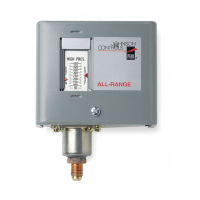P70, P72, and P170 Series Controls for Dual Pressure Applications Installation Instructions
8
Piping
P70, P72, and P170 dual pressure controls are typically connected to the controlled equipment by a capillary
(except ammonia compatible models). These controls are available with a variety of pressure connection styles.
Avoid severe pressure pulsation at high side pressure connections. Install pressure connection to pressure-tap
points away from the compressor, to minimize the effects of pressure pulsation from reciprocating compressors.
Setup and Adjustments
Adjustment of the P70, P72, and P170 dual pressure controls varies depending on the model. The following
guidelines and diagrams illustrate the procedures for adjusting these controls. Refer to the product label inside the
control cover for model number and switch action, and check the front of the control cover to determine if the
control is All-Range or MICRO-SET® model. See Figure 9 for an illustration and instructions on control
adjustments.
CAUTION: Risk of Environmental and Property Damage.
Avoid sharp bends in the capillary tubes. Sharp bends can weaken or kink capillary tubes, which may
result in refrigerant leaks or restrictions of flow.
CAUTION: Risk of Environmental and Property Damage.
Coil and secure excess capillary tubing away from contact with sharp or abrasive objects or surfaces.
Vibration or sharp or abrasive objects in contact with capillary tubes can cause damage that may result
in refrigerant leaks or loss of element charge, which may result in damage to the environment or
property.
IMPORTANT: If the control is installed on equipment that contains hazardous or regulated materials such as
certain refrigerants or lubricants, you must comply with all standards and regulations governing the containment
and handling of those materials.
IMPORTANT: Do not apply more than 9 ft·lb (12 N·m) of torque to the flare nuts on pressure connection line
fittings. Overtightening or applying more than 9 ft·lb (12 N·m) of torque may cause seal failure and will void the
warranty.
IMPORTANT: After installing the control, evacuate pneumatic and pressure connection lines to remove air,
moisture, and other contaminants in a manner consistent with applicable environmental regulations and
standards.
CAUTION: Risk of Property Damage.
Obtain and use the compressor manufacturer’s net oil bearing pressure specifications. If necessary,
reset the
cut-out pressure difference to the manufacturer’s specifications. Using improper pressure settings may
damage the control, compressor, or other controlled equipment.
IMPORTANT: Use the pressure control settings recommended by the manufacturer of the controlled
equipment. Do not exceed the pressure ratings of the controlled equipment or any of its components when
checking pressure control operation or operating the controlled equipment.
IMPORTANT: After mounting, wiring and evacuating the control, attach a reliable set of gauges to the
controlled equipment, and operate the equipment (at least) three cycles at the pressures necessary to verify
control setpoints and proper equipment operation.

